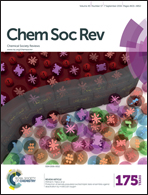Super-resolution fluorescent materials: an insight into design and bioimaging applications
Abstract
Living organisms are generally composed of complex cellular processes which persist only within their native environments. To enhance our understanding of the biological processes lying within complex milieus, various techniques have been developed. Specifically, the emergence of super-resolution microscopy has generated a renaissance in cell biology by redefining the existing dogma towards nanoscale cell dynamics, single synaptic vesicles, and other complex bioprocesses by overcoming the diffraction-imposed resolution barrier that is associated with conventional microscopy techniques. Besides the typical technical reliance on the optical framework and computational algorithm, super-resolution imaging microscopy resorts largely to fluorescent materials with special photophysical properties, including fluorescent proteins, organic fluorophores and nanomaterials. In this tutorial review article, with the emphasis on cell biology, we summarize the recent developments in fluorescent materials being utilized in various super-resolution techniques with successful integration into bio-imaging applications. Fluorescent proteins (FP) applied in super-resolution microscopy will not be covered herein as it has already been well summarized; additionally, we demonstrate the breadth of opportunities offered from a future perspective.


 Please wait while we load your content...
Please wait while we load your content...